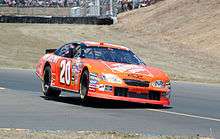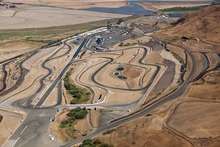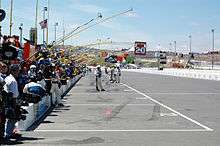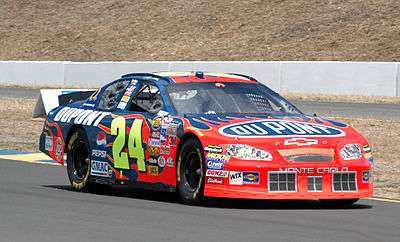Sonoma Raceway
| Sonoma Sears Point | |
|---|---|
|
_with_emphasis_on_Long_track.svg.png) _with_emphasis_on_NASCAR_track.svg.png) | |
| Location | 29355 Arnold Drive, Sonoma, California, 95476[1] |
| Time zone | UTC−8 / −7 (DST) |
| Capacity | 47,000 |
| Owner | Speedway Motorsports, Inc. |
| Operator | Speedway Motorsports, Inc. |
| Broke ground | 1967 |
| Opened | 1968 |
| Construction cost | $70 million USD |
| Former names |
Sears Point Raceway (1967–2001) Infineon Raceway (2002–2012) |
| Major events |
NASCAR Sprint Cup Series
Verizon IndyCar Series
NHRA Mello Yello Drag Racing Series Sonoma Historic Motorsports Festival
Formerly:
FIA World Touring Car Championship |
| Full Course | |
| Surface | Asphalt |
| Length | 2.52 mi (4.05 km) |
| Turns | 12 |
| Lap record | 1:21.688 (Marco Werner, Audi Sport North America, 2004, LMP1) |
| NASCAR Course | |
| Surface | Asphalt |
| Length | 1.99 mi (3.2 km) |
| Turns | 10 |
| Lap record | 1:14.186 (Kyle Larson, Chip Ganassi Racing, 2015, NASCAR Sprint Cup) |
| IndyCar/Motorcycle Course | |
| Surface | Asphalt |
| Length | 2.22 mi (3.57 km) |
| Turns | 11 |
| Lap record | 1:16.4913 (Ryan Briscoe, Chip Ganassi Racing, 2005) |
Sonoma Raceway, formerly Sears Point Raceway and Infineon Raceway is a 2.52-mile (4.06 km) road course and drag strip located on the landform known as Sears Point in the southern Sonoma Mountains in Sonoma, California, USA.[1] The road course features 12 turns on a hilly course with 160 feet (49 m) of total elevation change.[2] It is host to one of only two NASCAR Sprint Cup Series races each year that are run on road courses (the other being Watkins Glen International in Watkins Glen, New York). It is also host to the Verizon IndyCar Series and several other auto races and motorcycle races such as the American Federation of Motorcyclists series. Sonoma Raceway continues to host amateur, or club racing events which may or may not be open to the general public. The largest such car club is the Sports Car Club of America.
With the closure of Riverside International Raceway in Riverside, California after the 1988 season, NASCAR, wanting a west coast road course event to replace it, chose the Sears Point facility. Riverside International was razed for a shopping center development.
In 2002, Sears Point Raceway was renamed after a corporate sponsor, Infineon. However, as with many renamings of sports complexes, many people still call it by its original name. (It was never affiliated with Sears, Roebuck and Company, having been named for the nearby Sears Point Ranch founded in the 1850s by settler Franklin Sears.) On March 7, 2012, it was announced that Infineon would not renew their contract for naming rights when the deal expired in May, and the track management is looking for a new company to take over naming rights.[3] Until it can find a new corporate sponsor, the course is simply identifying itself as "Sonoma".
History
1968–1979
The 2.52-mile (4.06 km) road racing course was constructed on 720 acres (2.9 km2) by Marin County owners Robert Marshall Jr., an attorney from Point Reyes, and land developer Jim Coleman of Kentfield. The two conceived of the idea of a race track while on a hunting trip. Ground was broken in August 1968 and paving of the race surface was completed in November. The first official event at Sears Point was an SCCA Enduro, held on December 1, 1968.
In 1969 the track was sold to Filmways Corp., a Los Angeles-based entertainment company for $4.5 million. In May 1970 the track was closed and became a tax shelter for Filmways after losses of $300,000 were reported. Hugh Harn of Belvedere and Parker Archer of Napa arranged to lease the track from Filmways in 1973. Bob Bondurant, owner and operator of the Bob Bondurant School of High Performance Driving, and partner Bill Benck took over management and control of the leased raceway from Parker Archer and Hugh Harn in 1974. A few years later a group calling itself Black Mountain Inc., which included Bondurant, William J. Kolb of Del Mar and Howard Meister of Newport Beach, purchased the track from Filmways for a reported $1.5 million.
American Motorcycle Association national motocross races in the hills north of Turn 7 became popular with Bay Area fans, but were phased out by the end of the decade because of rising insurance costs.
1980–2000
In 1981 Filmways regained ownership of the track after a financial dispute with Black Mountain group. Jack Williams, the 1964 NHRA top-fuel drag racing champion, Rick Betts and John Andersen purchased the track from Filmways at an auction for $800,000. The track was renamed Sears Point International Raceway. In 1985 the track was completely repaved, in part with funds donated from the "Pave the Point" fund raising campaign. The first shop spaces (buildings A, B, C, and D in the main paddock area) were built.

In 1986 Harvey "Skip" Berg of Tiburon, CA took control of the track and became a major stockholder in Brenda Raceway Corp., which controlled the track until 1996. Additional buildings constructed on the property brought shop space to more than 700,000 square feet (65,000 m2) during 1987. In addition, a five-year contract was signed with the National Hot Rod Association for the California Nationals. The NASCAR Winston Cup Series debuted at the raceway in 1989.
In 1994 more than $1 million was spent on a beautification project and construction of a 62-foot (19 m)-high, four-sided electronic lap leader board in the center of the road course. In the following years a major $3 million renovation plan included VIP suites and a two-story driver's lounge/emergency medical facility. In 1995 Trans-Am and SportsCar races returned to Sears Point and the NASCAR Craftsman Truck Series was added to the major-events schedule. Owner "Skip" Berg sold the track to O. Bruton Smith, chairman of Speedway Motorsports, Inc. in November 1996.

Major renovations began at Sears Point Raceway in 1998 with the creation of "The Chute", an 890-foot (270 m) high-speed stretch. The first-ever running of the American Le Mans Series took place at Sears Point in July 1999. In 2000 Sears Point Raceway gained unanimous approval from the Sonoma County Board of Supervisors by a 5–0 vote to begin work on a $35 million Modernization Plan that included 64,000 Hillside Terrace seats, repaving of both the road course and drag strip and increased run-off around the entire track.
2000–present
After the turn of the millennium, Infineon Technologies bought the naming rights, renaming the course Infineon Raceway. In 2006, the Grand Prix of Sonoma was transferred to the Rolex Sports Car Series, who would limit it to Daytona Prototypes only for 2007–2008 before the event was discontinued altogether. Since 2010, however, the course has seen a mild resurgence, with the circuit becoming a sponsor for various events as well as hosting an increasing amount of lesser series, including the WTCC and the return of the SCCA World Challenge. The year 2012 saw the end of Infineon as the corporate sponsor, with the track renaming itself Sonoma Raceway.
Layouts

Full circuit

The standard, full length road course at Sonoma Raceway is a 2.52 miles (4.06 km) 12-turn course. This course was utilized by all competition through 1997. Most races, including the Grand Prix of Sonoma, use the full course. The course is noted for turns two and three, which are negative-camber ("off-camber") turns, with the inside of the turn higher than the outside. This provides a challenge for the driver, as turn two would normally have the drivers moving to the left side of the track.
The raceway also has a 440-yard (402.3 m) dragstrip used for NHRA drag racing events. The drag strip was originally located on part of the front straightaway of the course. Track changes completed in 2002 separated the road course from the drag strip.[4]
The Sonoma Historic Motorsports Festival, an annual classic car racing event, uses the full circuit.
The Chute
The track was modified in 1998, adding the Chute, which bypassed turns 5 and 6 (the Carousel), shortening the course to 1.95 miles (3.14 km). The Chute is only used for NASCAR events such as the Toyota/Save Mart 350, and was criticized by many drivers, who prefer the full layout. In 2001, it was replaced with the 70° turn, 4A bringing the track to its current dimensions of 1.99 miles (3.20 km).[5]
The Chute was built primarily for spectator visibility, to increase speeds, and improve competition for the stock cars, which are not necessarily groomed well for road course racing. However, it has been criticized for taking away a primary passing point, and some INDYCAR drivers believe eliminating The Chute and replacing it with a new hairpin at Turn 4A, then rejoining the track at Turn 5, would create a circuit with three passing zones (Turn 4, Turn 7, and Turn 11). Furthermore, the speeds of the current layout with The Chute have been slower than if the full configuration was used.
Gilligan's Island
From 1989 to 2001, the pit road could only accommodate 34 pit stalls. So, during the Toyota/Save Mart 350 NASCAR Sprint Cup race, some teams were required to share pit stalls while other teams were forced to pit inside the garage area. When cars dropped out of the race, their pit stalls were reassigned to cars who were sharing.
After a few years, a makeshift auxiliary pit road was constructed inside the hairpin (turn 11) nicknamed Gilligan's Island. Cars that had the nine slowest qualifying speeds were relegated to these pit stalls. Pitting in this area was considered an inconvenience and a competitive disadvantage, more so than even the disadvantages one would experience pitting on the backstretch at a short track at the time.[6]
Since the length of the auxiliary pit road was significantly shorter than the main pit road, the cars that pitted there were held from 15–20 seconds to make up for the time that would have been spent if the cars had traveled the entire main pit road.[7]
Pitting on Gilligan's Island had several other inconveniences. The location (the staging area for drag races) was landlocked by the race course, and crew members were unable to leave once the race began. Teams sent only the primary pit crew to Gilligan's Island, and once they were there, they could not access the garage area or their transporters to collect spare parts/tools. The only repairs that could be made were routine tire changes and refueling, as well as only minor repairs. Other auxiliary pit crew members, who were not part of the main crew, were staged in the garage area, and would have to service the car if it required major repairs. If a team pitting on Gilligan's Island dropped out of the race, the crew was unable to pack up their supplies and prepare to leave (a common practice at other tracks) until the race was over.
Modified course
_with_emphasis_on_Moto-IRL_track.svg.png)
Variations of Sonoma's circuits are often used. Motorcycles use a 2.22 miles (3.57 km), 12-turn course. It is based on the full layout, and does not include the Chute. This layout, opened in 2003, skips the later section of the Esses (8A and 9) and the run from Turn 10 to Turn 11 (the hairpin), using instead Turn 11a as Turn 11 has no runoff. This hairpin is located just past the drag strip control tower and offers a fairly straight run to the start-finish line.
When the Pirelli World Challenge returned to Infineon Raceway in 2011, the modified course was used (as the series doubleheader was acting as a support event for the Indy race). During the broadcast, it was explained that the Indy course skips much of the high-speed esses due to the curving section from Turn 9 to 10 ending with no runoff, especially on the outside of the curved section (bordered by the drag strip), and precariously little runoff in the high-speed Turn 10.
Another factor in removing the hairpin is the fact that the turn is only visible from the garages or the bleachers behind the esses. This is due to grandstands built along the front straight that serve also as the drag strip's grandstands.
In some variants, the end of the dragstrip (instead of the Keyhole) is used to create a Magny Cours-style hairpin that joints the drag strip to Turn 7 to open an overtaking opportunity.
For the 2012 IndyCar race, the course was modified again. The Magny Cours-style hairpin in Turn 7 is being used to create a passing zone. Turn 9A (the chicane similar to Spa's new Bus Stop) is being widened by ten feet (~3 meters) to allow for more room. A new Turn 11B has been made, moving further past the drag strip tower (Motorcycle Turn 11), being lengthened by 200 feet (~61 meters) to create a passing zone (it is located just before the race logos painted in Turn 11), and is located where the drag strip staging area is located.
For the World Touring Car Championship race, the full configuration is being used, but with the bus stop replacing the esses.
_layout.png)
Records
| Driver | Car | Date | Speed | Time | Layout | |
|---|---|---|---|---|---|---|
| Fastest qualifying lap | Audi R8 | July 23, 2000 | 1:20.683 | 4.05 km (Full) | ||
| Fastest racing lap | Audi R8 | July 17, 2004 | 110.641 miles per hour (178.06 km/h) | 1:21.688 | 4.05 km (Full) | |
| Trans-Am qualifying | Qvale Mangusta | July 22, 2001 | 1:35.727 | 4.05 km (Full) | ||
| NASCAR qualifying | Chevrolet SS | June 27, 2015 | 96.524 miles per hour (155.34 km/h) | 1:14.354 | 3.2 km (NASCAR) | |
| NASCAR race | Toyota Camry | June 24, 2012 | 94.6 miles per hour (152.24 km/h) | 1:15:67 | 3.2 km (NASCAR) | |
| IndyCar qualifying | Dallara DW12 Chevrolet | August 17, 2016 | 108.248 miles per hour (174.21 km/h) | 1:16.2530 | 3.57 km (Indy) [8] | |
| IndyCar race | Dallara Honda | August 28, 2005 | 98.6 miles per hour (158.68 km/h) | 1:20:95 | 3.57 km (Indy) | |
| WTCC qualifying | Chevrolet Cruze 1.6T | September 22, 2012 | 86.206 miles per hour (138.74 km/h) | 1:45.235 | 4.032 km (WTCC) | |
| WTCC race | Honda Civic WTCC | September 10, 2013 | 84.206 miles per hour (135.52 km/h) | 1:46.905 | 4.032 km (WTCC) | |
| AMA Pro Superbike | Suzuki GSXR-1000 | May 17, 2008 | 1:34.731 | 3.57 km (Motorcycle) | ||
| Pirelli World Challenge GTS Race | Porsche Cayman S PWC | August 23, 2013 | 69.583 miles per hour (111.98 km/h) | 1:42.558 | km (PWC) | |
NASCAR Sprint Cup Series records

(As of June 22, 2014)
| Most wins | 5 | Jeff Gordon |
| Most top-5s | 14 | Jeff Gordon |
| Most top-10s | 18 | Jeff Gordon |
| Most starts | 22 | Jeff Gordon |
| Most poles | 5 | Jeff Gordon |
| Most laps completed | 2,233 | Jeff Gordon |
| Most laps led | 457 | Jeff Gordon |
| Avg. start (active) | 3.0 | Kyle Larson |
| Avg. finish (active) | 7.9 | Jeff Gordon |
| Source:[9] | ||
|---|---|---|
Seating capacity

Sonoma Raceway has a permanent seating capacity of 47,000.[10] This includes the grandstands and terraces around the track. During major races, hospitality tents and other stages are erected around the track, which brings the total capacity up to 102,000 seats. The facility underwent a major expansion in 2004 which resulted in 64,000 hillside seats, 10,000 permanent grandstand seats, a wastewater treatment facility, 100 acres (40 ha) of restored wetlands, permanent garages, new retail space, a go-kart track and a new drag strip.
Current series
- Sonoma Drift Series
- Sprint Cup Series
- Verizon IndyCar Series
- NHRA
- Formula D
- AMA Superbike
- Formula Car Challenge
- TTXGP race
- AFM Motorcycle Racing
- SCCA Pro Racing World Challenge
- NASCAR K&N Pro Series West
- Ferrari Challenge
- 24 Hours of LeMons
- San Francisco Region SCCA
- National Auto Sport Association
Former series
- Grand Am 2006–2008
- American Le Mans Series 1999–2005
- Trans Am Series 1969, 1978, 1981–1993, 1995, 2001
- IMSA GT Series 1976–97
- Can Am Series 1977, 1980, 1984
- Camping World Truck Series 1995–1998
- Formula 5000 1969–1970
- World Touring Car Championship 2012–2013
Major events
NHRA Mello Yello Drag Racing Series
| Year | Date | Event | Category | Winning Driver |
|---|---|---|---|---|
| 1988 | July 29−31 | Motorcraft Ford California Nationals | Top Fuel | Joe Amato |
| Funny Car | Mark Oswald | |||
| Pro Stock | Harry Scribner | |||
| 1989 | July 28−30 | Motorcraft Ford California Nationals | Top Fuel | Frank Bradley |
| Funny Car | Don Prudhomme | |||
| Pro Stock | Bob Glidden | |||
| 1994 | July 29−31 | Autolite Nationals | Top Fuel | Scott Kalitta |
| Funny Car | John Force | |||
| Pro Stock | Darrell Alderman | |||
| 2016 | July 29−31 | Toyota Sonoma Nationals | Top Fuel | J.R. Todd |
| Funny Car | John Force | |||
| Pro Stock | Greg Anderson | |||
| Pro Stock Motorcycle | LE Tonglet |
Trans-Am Series
| Year | Category One Driver
Category One Vehicle |
Category Two Driver
Category Two Vehicle |
|---|---|---|
| 1969 | Mark Donohue
Chevrolet Camaro |
Don Pike
Porsche 911 |
| 1978 | Gene Bothello
Chevrolet Corvette |
Greg Pickett
Chevrolet Corvette |
| 1981 | Tom Gloy
Ford Mustang |
|
| 1982 | Tom Gloy
Ford Mustang |
|
| 1983 | Willy Ribbs
Chevrolet Camaro |
|
| 1984 | Greg Pickett
Mercury Capri |
|
| 1985 | Willy Ribbs
Mercury Capri |
|
| 1985 | Willy Ribbs
Mercury Capri |
|
| 1985 | Elliott Forbes-Robinson
Buick Somerset |
|
| 1986 | Wally Dallenbach Jr.
Chevrolet Camaro |
|
| 1986 | Wally Dallenbach Jr.
Chevrolet Camaro |
|
| 1986 | Wally Dallenbach Jr.
Chevrolet Camaro |
|
| 1987 | Scott Pruett
Merkur XR4Ti |
|
| 1988 | Willy Ribbs
Chevrolet Camaro |
|
| 1989 | Darin Brassfield
Chevrolet Corvette |
|
| 1990 | Darin Brassfield
Oldsmobile Cutlass |
|
| 1991 | Darin Brassfield
Oldsmobile Cutlass |
|
| 1992 | Darin Brassfield
Chevrolet Camaro |
|
| 1993 | Scott Sharp
Chevrolet Camaro |
|
| 1995 | Dorsey Schroeder
Ford Mustang |
|
| 2001 | Brian Simo
Qvale Mangusta |
Artistic presentations
In the 1970 motorcycle road racing film Little Fauss and Big Halsy, starring Michael J. Pollard and Robert Redford, Redford's character, Halsy, saw Sears Point as the brass ring in the world of racing, and the film was loosely based around that idea.
Sonoma has been featured in many racing video games, beginning with Papyrus's NASCAR Racing for the PC, released in 1994 and has been a frequent addition to NASCAR based games and more recently road course variations have appeared.
See also
References
- 1 2 Contact us at the Wayback Machine (archived February 13, 2014)
- ↑ "Raceway Track Facts". Sonoma Raceway website. Speedway Motorsports. Retrieved January 15, 2013.
- ↑ "Sonoma Raceway to lose Infineon name". San Francisco Chronicle. Hearst Communications Inc. March 8, 2012. p. B-2. Retrieved March 8, 2012.
- ↑ "Track History". racesonoma.com. Retrieved 30 August 2015.
- ↑ http://www.racingwest.com/news/story.php3/2094/index.htm
- ↑ http://www.thenascarinsiders.com/2010/06/14/do-you-remember-gilligans-island/
- ↑ "Jayski's Sears Point/Sonoma Raceway Past News". Retrieved 2002. Check date values in:
|access-date=(help) - ↑ http://autoweek.com/article/indycar/simon-pagenaud-chevrolet-wins-finale-verizon -indycar-series-championship-team-penske
- ↑ "NASCAR Sprint Cup Drivers' Statistics for Sonoma Raceway". Racing-Reference. FOXSports. Retrieved 2013-06-23.
- ↑ "FAQs". corporate-ir.net. Retrieved 30 August 2015.
External links
| Wikimedia Commons has media related to Sonoma Raceway. |
- Sonoma Raceway Official Site
- Sonoma Raceway race results at Racing-Reference
- Map and circuit history at RacingCircuits.info
- Trackpedia guide for this track
- High Resolution image from Google Maps
Coordinates: 38°09′36″N 122°27′34″W / 38.16006°N 122.45940°W

